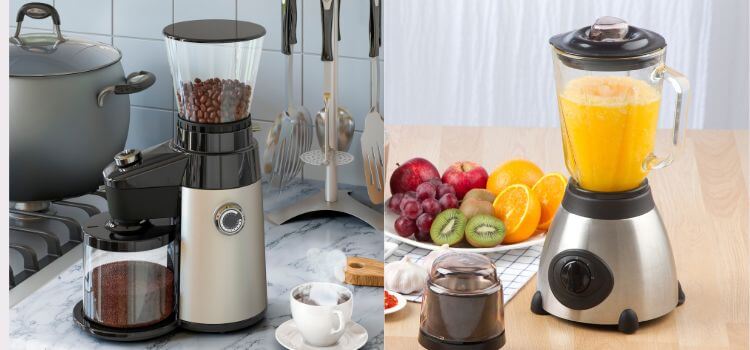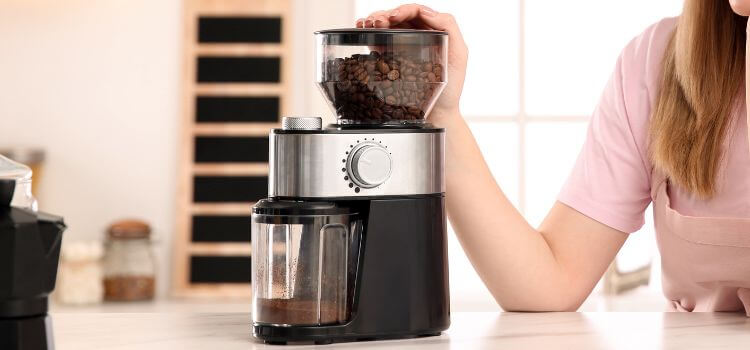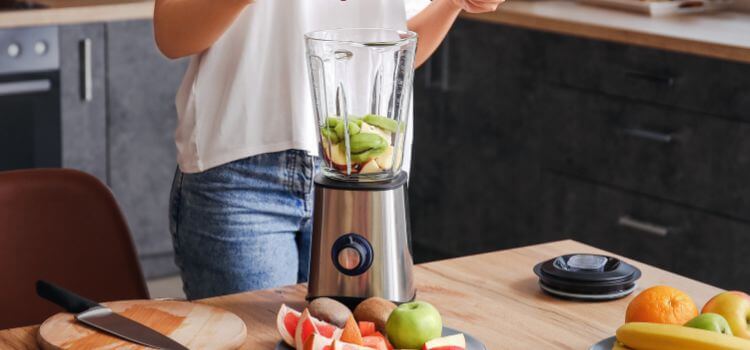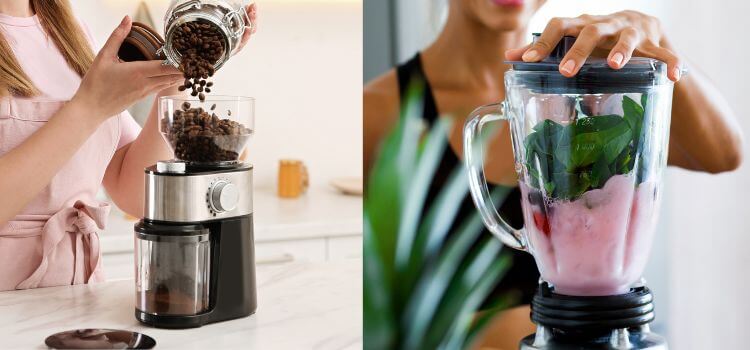As an Amazon Associate, I earn from qualifying purchases

In the quest for the perfect cup of coffee, enthusiasts are often faced with a pivotal decision: should they invest in a dedicated coffee grinder, or can a standard kitchen blender do the trick? This question is not just about convenience but also about the quality of the grind and, ultimately, the taste of the coffee.
In this comprehensive article, we will delve deep into the showdown between coffee grinders and blenders, exploring the nuances that differentiate these two appliances. From the consistency of the grind to the flavor extraction and the overall impact on your morning brew, we aim to equip you with all the information you need to make an informed decision.
So,Let’s dive into this caffeinated adventure together and determine whether a coffee grinder or a blender suits you best.
Understanding Coffee Grinders

Types of Coffee Grinders
- Blade Grinders: These grinders employ blades to chop the coffee beans, leading to an inconsistent grind size.
- Burr Grinders: These grinders, known as burr grinders, utilize two rotating abrasive surfaces (burrs) to meticulously crush the coffee beans, ensuring a uniform grind size that is crucial for extracting the best flavors and aromas from the beans.
Burr grinders are essential tools for coffee enthusiasts looking to achieve the perfect grind size. Within the category of burr grinders, there are two main types – conical burr grinders and flat burr grinders.
Conical burrs are cone-shaped and tend to produce a more consistent grind, while flat burrs have two parallel rings that grind the beans between them.
Pros of Using a Coffee Grinder
- Consistency: A coffee grinder provides you with a uniform grind size, which is essential for extracting optimum flavor from your beans.
- Control: Using a coffee grinder grants you the flexibility to customize the grind size to match your preferred brewing technique. This degree of control empowers you to refine the flavor and intensity of your coffee.
- Freshness: Grinding coffee beans just before brewing ensures maximum freshness, as ground coffee quickly loses its flavor and aroma over time.
Cons of Using a Coffee Grinder
- Cost: Dedicated coffee grinders can be expensive, especially if you opt for a high-end burr grinder. There may be a more feasible investment for occasional coffee drinkers.
- Maintenance: Burr grinders require regular cleaning and maintenance to ensure consistent performance. They also tend to produce a lot of static electricity, which can be messy and inconvenient.
Understanding Blenders

Types of Blenders
- Immersion Blenders: Hand blenders, also referred to as immersion blenders, are portable devices designed to blend and mix ingredients directly within a container.
- Countertop Blenders: These are larger, more powerful blenders with a base and a pitcher for blending more significant quantities of ingredients.
Pros of Using a Blender
- Versatility: Blenders have multiple uses beyond just grinding coffee beans. Ideal for creating smoothies, sauces, and beyond.
- Affordability: Blenders are generally more affordable than coffee grinders, making them a budget-friendly option.
Cons of Using a Blender
- Inconsistent Grind: As blenders are not specifically designed to grind coffee beans, they often produce an uneven grind size.
- Lack of Control: Blenders typically have limited options for adjusting the grind size, which can limit your ability to customize your coffee according to your preferences.
- Risk of Overheating: Blenders may overheat when grinding coffee beans, which can affect the flavor and aroma of your coffee.
Comparative Analysis: Coffee Grinder vs Blender
Grind Consistency and Quality
Consistency plays a crucial role in grinding coffee beans effectively. A uniform grind size ensures even extraction of flavor and aroma, resulting in a well-balanced cup of coffee. This is where burr grinders have an edge over blenders, as they are specifically designed for achieving consistent grind sizes.
- Impact on Coffee Flavor: Consistent grinding size is key for even extraction of coffee grounds, leading to a well-balanced and flavorful cup of coffee.
- Impact on Brewing Methods: The type of brewing method you use can also affect the choice between a coffee grinder and a blender. For example, If you favor a French press or a pour-over brewing method, a burr grinder is essential for achieving the coarse grind size required for these methods.
Cost-Efficiency and Investment
- Initial Cost vs Long-Term Value: While blenders are generally more affordable than coffee grinders, investing in a high-quality burr grinder can save you money in the long run. This is because whole coffee beans tend to be less expensive and have a longer shelf life compared to pre-ground coffee.
- Frequency of Use: If you only drink coffee occasionally, a blender may be a more cost-efficient option.
Ease of Use and Maintenance
- Learning Curve: Using a blender to grind coffee beans is simple, making it an excellent option for beginners.
- Maintenance: Blenders are generally easier to clean and maintain compared to burr grinders, which require regular disassembly and cleaning of the burrs.
Making the Right Choice for You

Assessing Your Coffee Preferences
When choosing between a coffee grinder and a blender, it’s essential to assess your coffee-drinking habits and preferences. Consider the frequency of use, the desired brewing method, and the level of control you want over your coffee’s flavor and strength.
Lifestyle Considerations
It’s also essential to consider your lifestyle and available space when choosing between a coffee grinder or a blender. If you have limited counter space, an immersion blender may be a more practical option compared to a bulky countertop blender or burr grinder.
Recommendations for Specific Needs
- Best for Espresso Enthusiasts: For espresso enthusiasts, a top-notch burr grinder is a must-have to achieve the finely ground coffee necessary for this brewing technique.
- Best for Casual Coffee Drinkers: For occasional coffee drinkers or those on a budget, using a blender can be a cost-effective option. Note that it might not offer the equivalent consistency and control found in a coffee grinder.
Conclusion
While both a coffee grinder and a blender can be used to grind coffee beans, they have significant differences in terms of consistency, cost-efficiency, and ease of use. Ultimately, your decision between the two options will be influenced by your individual preferences and lifestyle requirements.
No matter which option you choose, grinding your coffee beans at home is sure to elevate your coffee-drinking experience with its freshness and flavor. Feel free to experiment and discover the one that suits you best. Enjoy brewing!
As an Amazon Associate, I earn from qualifying purchases
Pingback: How To Clean Black And Decker Coffee Maker